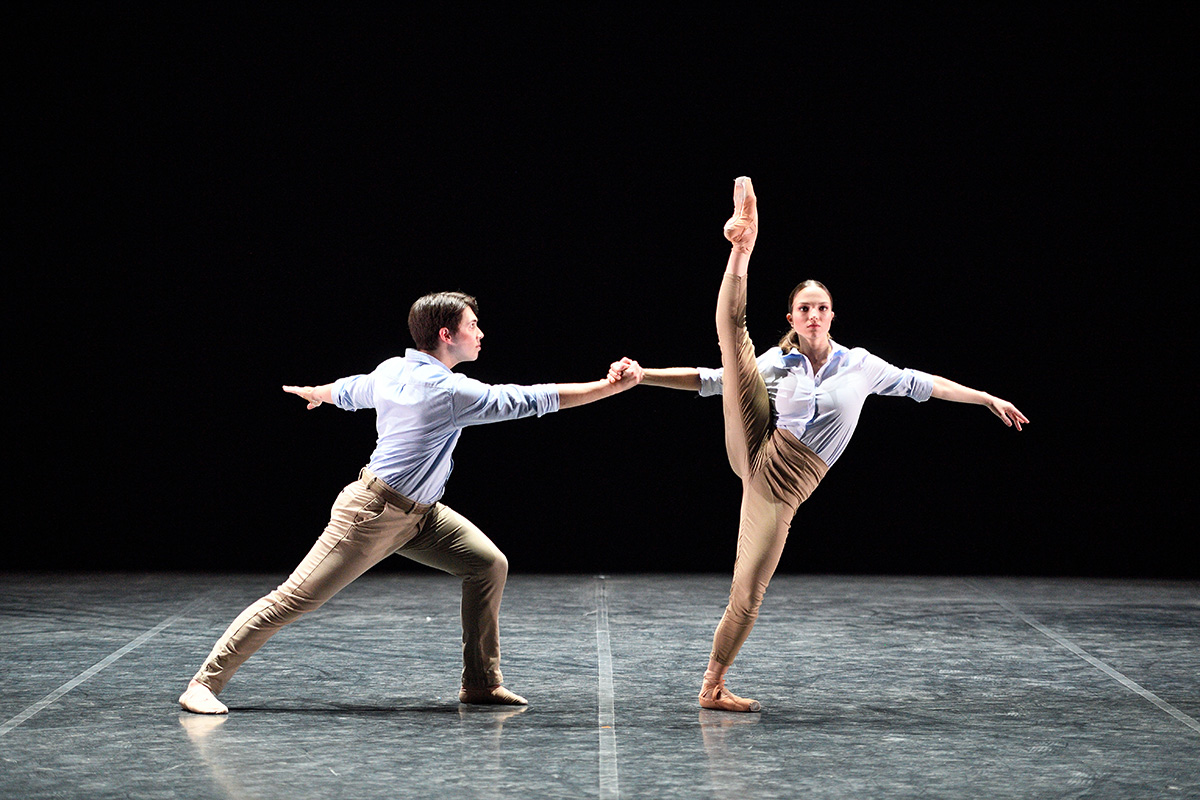
© Laurent Liotardo. (Click image for larger version)
English National Ballet
Emerging Dancer Competition
★★★★✰
Streamed from ENB’s Holloway Production Studio
22 September 2020
www.ballet.org.uk
The 2020 ENB Emerging Dancer Competition finalists were:
Ivana Bueno, Carolyne Galvao, Miguel Angel Maidana, Victor Prigent, Emily Suzuki and William Yamada.
DanceTabs interview with the 6 finalists
English National Ballet’s 11th annual competition for aspiring members of the company went ahead in spite of restrictions imposed because of the Corona virus pandemic. Presenter Ore Oduba introduced the online programme from ENB’s new headquarters on City Island in east London, giving viewers glimpses of the impressive building from outside and within. The six competitors performed on the stage of the in-house Holloway Production Studio to a socially distanced audience seated around dining tables. The necks of wine bottles framed the camera’s front angle view of the performances.
ENB’s Philharmonic orchestra was installed in a studio upstairs, the masked and carefully distanced players wired for sound as music director Gavin Sutherland conducted via a monitor screen view of the dancers below.
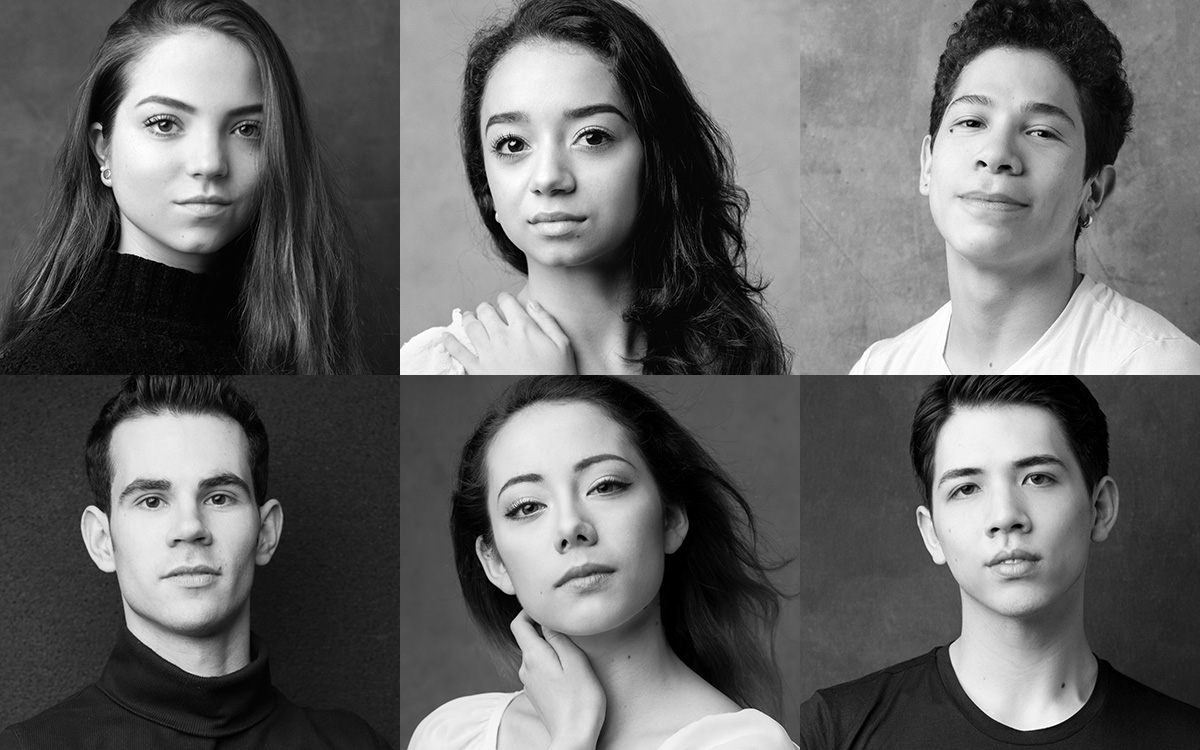
© Karolina Kuras. (Click image for larger version)
The competitors were required to perform a classical pas de deux in the first half of the programme and a newly created one in the second section. After eight months without performances, the dancers had to recall how to engage with an audience as well as execute technical challenges. For the classical pas de deux, each couple had been coached by more senior members of the company – Sarah Kundi, Senri Kou and Pedro Lapetra.
First up were Emily Suzuki and Victor Prigent in the Satanella pas de deux, also known as the Carnival de Venise duet from its music title by Pugni. It’s a virtuoso gala number, with choreography allegedly by Petipa. Both dancers projected charmingly, though Suzuki could have done with more attack in her demanding solo variations. Prigent, who has had experience with other companies before joining ENB, was a gallant partner. He won the audience award, voted by online viewers – I suspect for his moving performance in the second half rather than his accomplishment in the Satanella opener.

© Laurent Liotardo. (Click image for larger version)
Next came Ivana Bueno and William Yamada in the Talisman pas de deux to music by Drigo and Pugni. Another gala staple, it has nothing to do with Petipa’s 1889 ballet of the same name: the Soviet era choreography is by Pyotr Gusev, Kirov ballet master in the 1950s. However, the male dancer usually wears some kind of ‘oriental’ outfit, in tribute to the maharajah character in the Talisman ballet – a costume that did Yamada no favours. Bueno, in a tunic with a crown on her head, had a story to tell as she pleaded prettily with her partner, perhaps begging for the return of her talisman. A musical dancer, she had a fine sense of style in the carriage of her head and shoulders and in the use of her fingertips. Rightly, in my opinion, she won the Emerging Dancer Award. From Mexico, she joined ENB straight after graduating from the Princess Grace Academy in 2018. She’s very evidently a talent to watch.

© Laurent Liotardo. (Click image for larger version)
The third pair, Carolyne Galvao and Miguel Angel Maidana, performed the Diana and Actaeon pas de deux choreographed by Agrippina Vaganova in 1935. As the huntress Diana, Galvao was more concerned with executing her balances and multiple pirouettes than with communicating with the audience. Like the other two female contestants, she is a formidable turner. Maidana has an explosive jump but raises his shoulders effortfully. Probably, like Yamada, he is not fully fit after so long a time in confinement, which has been tough on male dancers who need to be able to cover space.
The most affecting of the recently created duets was Stina Quagebeur’s The Hollow, for Emily Suzuki and Victor Prigent. It tells of a fraught relationship, to plangent music by Giovanni Solima. The woman appears haunted with grief, unable to meet her partner’s eyes or respond to his urgent caresses. Perhaps she has lost a child. The man cradles and supports her even as she pulls away from him. As he becomes more insistent, she grows more distressed until she suddenly surrenders, meeting his eyes at last. They end as they began, with him embracing her from behind. But will the reconciliation endure? Both dancers conveyed the shifting moods of the duet well, sympathetically filmed from different camera angles. Laurent Liotardo was responsible for the recording.
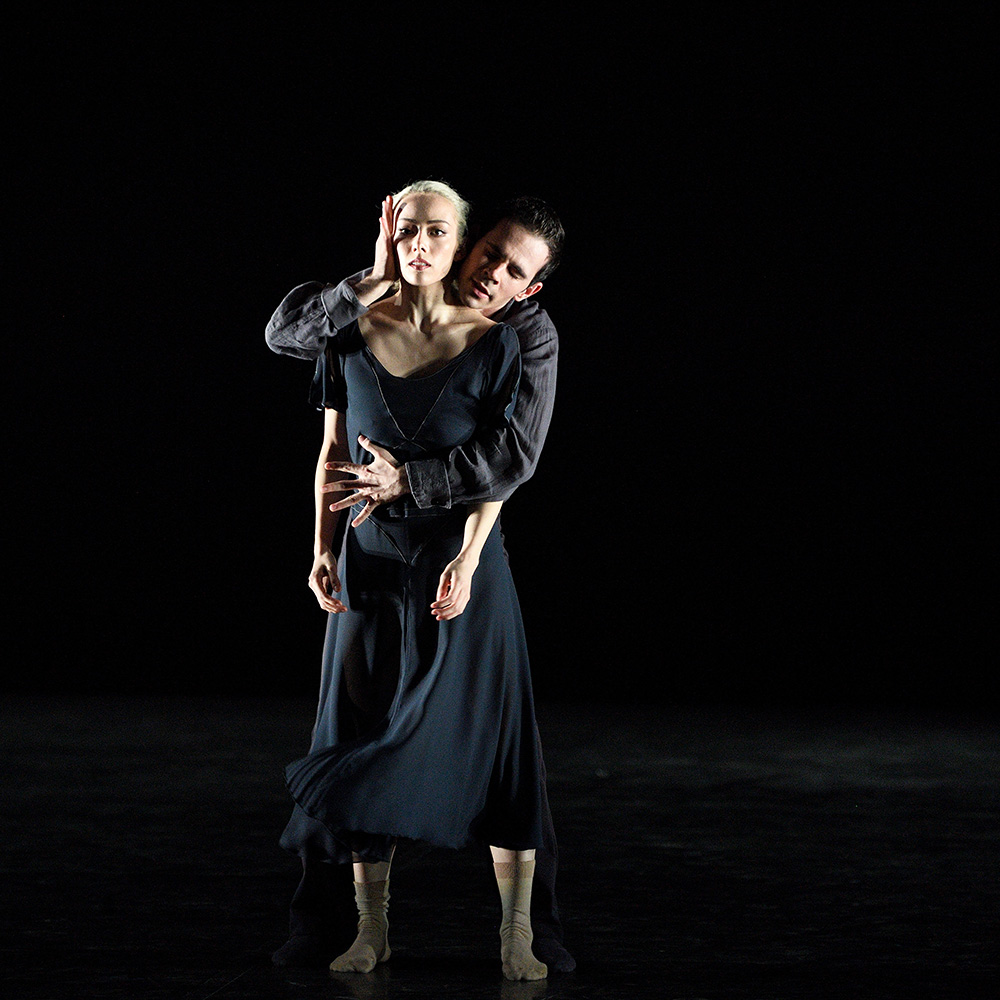
© Laurent Liotardo. (Click image for larger version)
Mthuthuzeli November of Ballet Black choreographed Full Out, to music by David Lang, for Ivana Bueno and William Yamada, identically dressed in pale blue shirts and beige trousers. Their conflicted relationship was that of rival siblings rather than lovers, with both vying for the upper hand. November had combined acrobatic ballet partnering with the more grounded moves of African dance. Bueno’s dagger-like legs and feet in pointe shoes threatened Yamada, who gave as good as he got, fully engaged in their contest. She won, shoving him down at the end.
I wasn’t sure what to make of Jeffrey Cirio’s Both of Two for Carolyne Galvao and Miguel Angel Maidana, not least because the lighting was so dark. The couple initially appeared to be under water, pulsing like jellyfish, side by side or intertwined. The music by Danilo Walde changed half way to a version of Albinoni’s familiar adagio, for no obvious reason. It inspired the performers to rise, writhe and wave their arms sinuously before engaging in upside down lifts. Though the nature of their relationship was obscure, they both looked committed to Cirio’s choreography.

© Laurent Liotardo, post-production by Nik Pate. (Click image for larger version)
While the judges conferred, viewers were treated to performances by previous winners of the awards: Julia Conway danced the solo variation from Esmeralda, and Rhys Antoni Yeomans threw himself into a quirky vaudevillian number created by Arielle Smith. Still only 22, Smith trained at the Rambert school and company before becoming a young associate choreographer with Matthew Bourne’s New Adventures. Mañana Iguana is a spirit raiser, perfect for the occasion and for future galas.
The judges were Matthew Hart, Kerry Nicholls, Natalia Osipova, Kenneth Tindall and Edward Watson Watching online, it was impossible to tell whether they were present in the studio theatre or voting remotely. Masked figures standing on stage during Oduba’s introduction were unrecognisable, apart from artistic director Tamara Rojo’s dark eyes. At the end of the competition, she announced the winners of the awards, which included one for a valued member of the corps de ballet, which went to South African Claire Barrett. The recipients had to collect their awards themselves from an on-stage table, since no touching was allowed under Covid-19 conditions. Rojo thanked everyone for their ‘Herculean efforts’ in enabling the Emerging Dancer Competition to take place – the first live performance in the new building. Credit must be given to the performers – dancers and musicians – for conquering their nerves in such unusual circumstances, and to the technical staff who accomplished a seamless online transmission from a hitherto untried studio theatre. Well done, ENB!












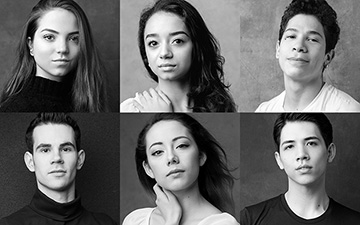

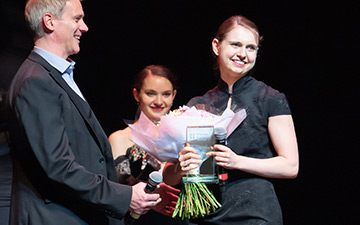


You must be logged in to post a comment.